 |
|
Petroleum Centre, 1867
"The Wild, Wild East"
|
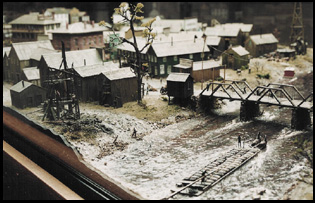 |
|
|
|
| |
|
|
|
|
2002 -- Oil Creek Pennsylvania State
Park with the Oil Heritage Region, Inc.
Size: 48 in.
x 96 in. (4 ft. x 8 ft.)
Scale: 1/8 in. = 1 ft. (1/87th scale, or HO gauge)
Figures: 221 at 3/4 in. tall, involved in dozens of action vignettes.
Features: a dual-gauge railroad, oil derricks, hundreds of oil
barrels, oil barges, horses & wagons, 61 scratch-built buildings,
and oil-fouled Oil Creek. Display case designed to allow wheelchair access
under diorama for close-up viewing per ADA recommendation.
|
|
|
|
| |
|
|
|
|
The Problem:
The staff of Oil Creek State Park required
a diorama to create the centerpiece for their recently constructed Visitor’s
Center. The purpose of the exhibit was to depict a moment during the height
of Petroleum Centre’s short and unusual life, and in particular,
the various activities of more than two hundred little people who are
shown. All this is in dramatic contrast to the bucolic wooded park land
to which Petroleum Centre has reverted, with only one of it’s more
than one hundred original buildings still standing.
|
|
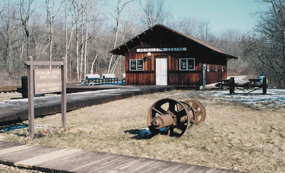
The new depot for receiving tourist trains, and the home
of the Petroleum Centre diorama.
|
|
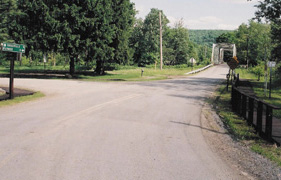
The current park appearance at what had been the main intersection
and town center of Petroleum Centre |
|
|
|
| |
|
|
|
|

Looking at the Petroleum Centre diorama from the west, showing
the entire 4 ft. x 8 ft. diorama footprint. |
|
|
|
| |
|
|
|

Looking at the Petroleum Centre diorama from the east.
|
|
|
|
| |
|
|
|
| |
|
|
|
|
The Challenge:
To compress, into the space allowed by the dictates of the size of the
Visitor Center and ADA requirements, enough of the essential activity
associated with the drilling, storage and shipping of Pennsylvania crude
to give visitors a sense of what life was like just outside the new Visitor's
Center doors in 1867. A second request was to make a dramatic contrast
between the harsh effects of early oil-drilling on the natural environment,
and the return of that same environment to it's current pristine natural
state, a Pennsylvania hardwood forest.
|
|
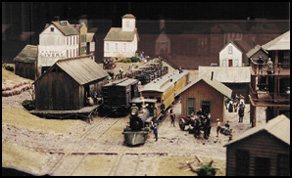
A dual-gauge railroad line has just been completed
allowing both standard and broad gauge equipment to serve the transportation
needs of the oil boom town. The train from Titusville, 9 miles north, has
just arrived on its way to Oil City on the Allegheny River, 9 miles south
of Petroleum Centre.
|
|
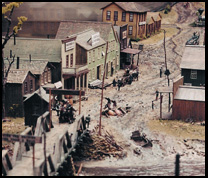
Heavy spring rains caused muddy sink holes resulting in the
reputation for "roads that are unpassable, not even jack-assable".
A team, wagon, oil barrels and teamster have strayed into the 'Main Street
stew". |
|
|
|
| |
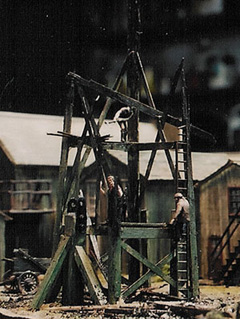
Workers salvage reusable hardware from a burned well. Fires
were a frequent problem, and eventually large portions of the town were
lost to fires.
|
|

A man sits on top of a derrick, there to grease the crown-pulley
and keep the lines from tangling.
|
|
|
|
| |
|
|
|
|
The Solution: We spent
a week in the area researching "the story". This included interviews
with local historians and hours spent in the local historical archives
scanning their robust collection of black and white pictures taken by
a local photographer who chronicled the period and the area. (That photographer,
John Mather, can be seen in the diorama standing in the middle of the
street preparing to take a photo.) From Mather's images, and a variety
of original historical sources including newspapers, letters and diaries,
we identified most of the buildings and businesses that stood on the two
main streets of the town in 1867. We also designed the diorama so that
it visually demonstrates how the oil was "drilled" for, stored
and transported by wagon, barge, and railroad to the rest of the world,
and how the oil was spilled during each of these activities. The diorama
also illustrates the essence of "boomtown" that existed, including
the commerce, pollution, rowdiness, burned-out structures and crowds of
people going about their business.
|
|
|
|
|
| |
|
|
|
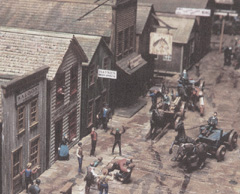 |
|
|
|
| |
|
|
| |
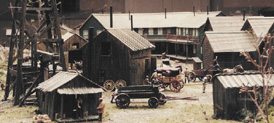
The wagon maker has just rolled his latest creation from
his shop into the sun - a new "taxi" wagon for the local teamster
whose "niche" has become ferrying the growing number of visitors
and new residents to and from - mostly from - the RR station. The taxi man
beams with anticipation as the wagon-maker beams with pride. |
|
| |
|
|
|
| A fight, started in Mrs. Mooney's
Rooming House (above), migrates into the planked street in honor of the
sunny break in the spring rains. A teamster pulls his team up short to avoid
trampling the combatants as a crowd gathers. One of the girls upstairs at
Mrs. Mooney's (over whom the fight started) adds her two cents worth. Across
from Mrs. Mooney's (below), a crew of men reclaims the salvageable items
from the burned-out remains of Levy's Dry Goods Store. |
|
| |
|
|
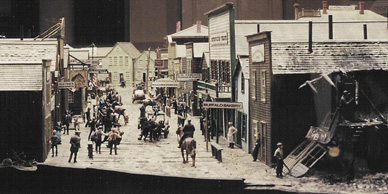 |
|
| |
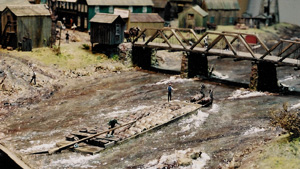 |
|
| A north-bound barge (above) loaded
with supplies and empty barrels holds up as the teamster waves to the south-bound
barge (below) to come on through this treacherous narrow spot. |
|
|
| |
|
| |
|
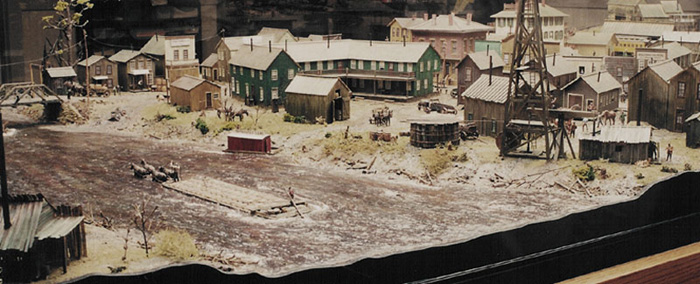
A southbound barge loaded with barrels of oil and controlled
by a teamster and his team of four horses and a tillerman at the stern approaches
the narrow bridge openings followed by a tight bend. The northbound bargeman
- on the other side of the bridge (above, right) - has waved his intention
to hold his lighter and more manuverable barge there against the current,
giving the right of way to the heavier, less manuverable barge, a handful
as it runs with the current of the rain-swollen creek. The water
shows the extent of oil contamination mixed with muddy run-off from the
banks of Oil Creek.
|
|
|
|
|
|
Website designed by Moments In Time Exhibits
Contact webmaster
with comments/questions.
|
|
|
|
|
|
|
|
|
|
|
|
|
|
|
|
|
|
|
|













